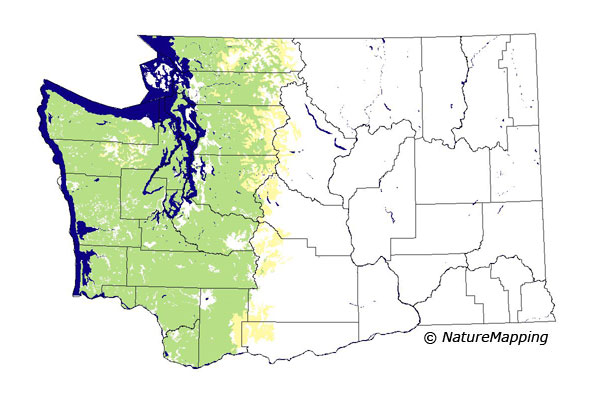GAP Analysis Predicted Distribution Map
Northwestern Salamander (Ambystoma gracile)
Species Code: AMGR
|
Legend:
 = Core Habitat = Core Habitat
 = Marginal Habitat = Marginal Habitat
Metadata
(Data about data or how the map was made)
Predicted Distribution
Amphibians do not migrate as some birds and mammals, so the colored areas depict the predicted range for the Northwestern Salamander year-round. The habitats were identified using 1991 satellite imagery, other datasets and experts throughout the state, as part of the Washington Gap Analysis Project.
Click to enlarge distribution map
|
This species is found at sea level up to 1,745 meters. It is known from Whidbey Island. It spends most of its time underground, but may be observed at night in large ponds and lakes during breeding season.
This species is generally not found in upland hardwood forests, non-forested areas, agriculture or high-density developed habitats. The terrestial forms may be found up to a mile away from their breeding ponds within mixed and conifer forests and occasionally in areas of low-density housing. Riparian floodplain pools may offer good habitat.
All the ecoregions west of the Cascades, plus areas slightly over the crest into the East Central Cascades and Southeast Cascades region were selected for modelling.
the treatment of zones varied with ecoregion. In western Washington, the core zones were all lower elevation zones, plus the Western Hemlock and Silver Fir zones.
In the Olympics and Southwest Cascades, Mountain Hemlock was core and Alpine/Parkland was peripheral habitat. In the Northwest Cascades, Interior Douglas-fir and Mountain Hemlock were peripheral and Alpine/Parkland was excluded.
Peripheral zones in the Southeast Cascades included the Interior Douglas-fir, Interior Western Hemlock, Grand Fir, Ponerosa Pine and Oak, while Western Hemlock, Mountain Hemlock and Alpine/Parkland were core. The Interior Western Hemlock zone was peripheral and all others were excluded in the East Central Cascades.
Lakes, marshes and riparian areas were good habitats in all zones. In most zones, all forests and low-density development were suitable where wet areas were included. Only lakes and marshes were included as good habitat in the Oak and Ponderosa Pine zones. In the Alpine/Parkland zones, only conifer forests were potentially suitable.
Available records are inadequate to demonstrate that A. gracile enters the high-elevation zones in the Northwest Cascades. In the Southeast Cascades, it appears to be able to enter more of the drier east-side forest zones than it does in the East Central Cascades.
Translated from the Washington Gap Analysis Amphibians and Reptiles Volume by Karen Dvornich
Webpage designed by Dave Lester

 = Core Habitat
= Core Habitat = Marginal Habitat
= Marginal Habitat